

Fireman, Osaka City Fukushima Firestation
Sponsored by the Osaka-Shinsaibashi RC
I now realize just how little I knew about England, a country with which Japan has had a 400-year-long relationship.
The Great British Empire that reached to the corners of the world.
Manchester, the heartland of the Industrial Revolution. The ever-popular music of the Beatles. The country of the Queen ...
All of these I learned in my school days. The only new thing I knew about England was soccer player David Beckham.
I was certainly lacking in information that would be helpful to me during my
one-month stay in England.
The average temperature in London is 9.7 (in Osaka it's 16.5), the average
rainfall is 753 mm (Osaka 1350 mm), the highest mountain in Great Britain (1343
m) is Ben Nevis (Mt. Fuji 3776 m) and the longest river (354 km) is the River
Severn (Tone River 322 km). The biggest difference that concerned me was British
English. I had the impression that it was slightly different than the English
we had been taught in school. So with all these things floating around in my
head, I lugged my over-stuffed suitcases to Kansai International Airport and
departed for England.
My Impressions of England
The first thing that struck me upon my arrival in England was how cool it was!
When we left Osaka, it was the end of the summer. While we were in England,
they were having the nicest weather they had ever had at that time of the year,
and it continued all the time we were in England. It never rained, the temperatures
were like autumn in Osaka, and we were able to comfortably do everything that
had been scheduled for us.
The foliage there greatly resembles that in Japan. There were willows, poplars
and oak trees with acorns. In the public parks in the suburbs, I saw wild squirrels
frolicking about, and I even saw wild foxes and porcupines on the property of
my host families. All the yards I saw were true "English gardens,"
and they were so beautiful and well-kept.

The houses were mostly single-family dwellings made of brick with slate roofs,
or what they call "semi-detached" homes with two homes connected together.
It wasn't rare to see houses that were over 100 years old. The people use that
portion of the house that can still be used and renovate the interior, making
it possible to use the same building for many years. It was completely different
than Osaka, where we always knock down the old town-houses to build tall condominiums.
I will never forget seeing renovated homes that put heating stoves inside their
unusable fireplaces, and the way people innovated and made use of the old and
the new together. Using good things for a long time and keeping them beautiful
... There are many things that we super-consuming Japanese can learn from.
The British Way of Eating
Before going to England, I had experience living alone and in communal style,
but it was the first time in my life to experience a homestay. To do it at my
age made it an even more precious and unbelievable experience. I am often in
charge of preparing meals at the fire station (we work 24-hour shifts, so we
usually cook our own meals), so I was very interested in home-style cooking
in England.
I had the pleasure of staying with six families while I was in England. Unfortunately,
because we had many evening meals at various Rotary Clubs, I had only four opportunities
to eat supper with my host families the whole time I was in there. I had hoped
to be able to add to my repertoire as a cook, but I didn't learn to cook any
new meals. Based on what I saw while eating with my host families, eating at
pubs and hotel restaurants, I would like to share what I felt to be typical
dining trends in England. To be sure, the way the British and Japanese think
about "eating" is quite different. The biggest difference I noticed
was the difference in thinking regarding "dishing out the food" and
"seasoning" the food.
There is absolutely nothing in England that corresponds to the way we Japanese
use many small dishes for each course of the meal. The British pile everything
from the main course to the vegetables and potatoes all on one huge plate. For
this reason, they have a little need to concern themselves with detailed seasoning
of their food, because even if they went to the trouble of emphasizing the unique
tastes of each different course, everything would end up getting all mixed together
on the single plate.
For this reason, if I don't subtly season the food with salt or pepper before
eating it (or while eating), the food will not taste good to me. For example,
we were often served boiled kidney beans. Let's say they had been seasoned as
we do in Japan (with sugar, soy sauce and sesame seeds). Then, let's say the
main course is lamb with mint sauce. When the sesame seasoning and mint sauce
get mixed together ... it would result in a very weird taste mixture!
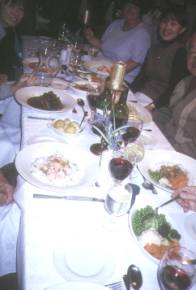
It seems to me that the British way of eating is to simply pile on the food
you want to eat and eat it with little fanfare. If one didn't know this and
tried to eat boiled kidney beans in England without any seasoning, they might
think, "The food in England isn't very delicious."
British Kitchens
All the homes I visited had beautifully painted plates decorating their kitchens.
Everything was beautiful, from the refrigerator to the trash can. There were
times when it took me a moment to find the door of the refrigerator. When helping
to get things ready for the meals, I often had to look in the refrigerator or
the cupboards. One thing that struck me was that the sink area in British homes
is very similar to what we have in one-room flats here in Japan. They seemed
quite small for the scale of the kitchen. When I was trying to prepare some
Japanese-style boiled beef and potatoes for one of my host families, it was
rather inconvenient for me to use the sink area. But, their stoves and grills
are very good. You can boil, fry, steam, broil, deep fry and warm up things
all on one stove, and you can do it at the same time!
I was able to prepare a meal much faster than expected in a British kitchen.
Since the sink area is so small, many people make use of pre-cut vegetables
that they buy at the supermarket. There is no comparing the variety available
in England with that in Japan.
Let me share one example of meal preparation. While boiling some small peeled
potatoes, the steam from the pan is used to cook some large pieces of cauliflower.
In a separate pan, carrots and kidney beans are boiled while the main dish is
cooked in a frying pan. The frying pan is then put as is into the oven. Chips
(potatoes) are then fried on the burner that was being used to cook the main
course previously. Some powdered cheese is sprinkled on the cauliflower and
it, too, is put in the oven. Just about the time the chips are done cooking,
the entire meal is ready. The whole thing takes about 20 to 30 minutes. While
the husband is cutting up the main dish, the wife uses the juices left in the
frying pan to make some gravy. Then everything is carried to the table, candle
sticks are placed on the table, the wine if opened and an enjoyable dinner begins.
It bears mention, however, that at the home where this meal was prepared, they
told me, "We only make meals like this on weekends." Maybe it was
because of the greater social mobility of women these days, or the fact that
the kitchen in this home seemed less efficient than the other homes I was in.
Anyway, it seems that there are many families in England that do not prepare
meals every day like we do in Japan. Instead, many people eat out or prepare
very simple meals most of the time. Whenever I had the chance to ask about the
husband's role in doing housework, I did so. The answers I received were, "I
put the dishes in the dishwasher," "I put the washed dishes back in
the cupboard," etc. It appears that, as in Japan, most of the housework
is still done by the wife. I wondered if this had something to do with the high
rate of divorce in England.
Shocking Dish Washing Method
Except for one host family (who was living in a rental home while their home
was undergoing large-scale renovations), all my hosts had dishwashers. I had
very few chances to see people wash dishes by hand, but when I did, I was, honestly
speaking, quite shocked. I watched as they washed some wine glasses. After washing
the glasses, they took a dish towel and dried the glasses with the soap suds
still on the glasses. They didn't rinse off the soap first.
At first, I thought it was just the washing style of the family I was staying
with, but later, at another home, two or three times I saw them put the soapy
cups and plates on the dish drying rack to dry! It was then that I realized
they don't rinse their dishes in England. I think it might be a holdover from
the days when plumbing was not so efficient, but they don't seem to have the
custom of completely rinsing their dishes, as we do in Japan. As I mentioned
earlier, they like to put all their food on one big plate. I wonder if this
custom has something to do with poor plumbing in the past.
To be sure, there were some houses that did not have much hot water pressure
in their shower rooms on the second floor. Even the shower rooms at the fire
stations I visited had poor water flow, I was told. I felt like the water system
in Japan is better than that in England.
Automobiles in England
Almost all of my host families have cars to get around. As soon as I got in
the car, I realized that things in England are very similar to Japan. They drive
on the left side of the road, and the meaning of their road signs are basically
the same as in Japan. I felt that I would be able to get used to driving in
England rather quickly, but then I saw a "roundabout." We don't have
anything like this in Japan. Roundabouts are rotary intersections.
In the middle of an intersection, there is a flower bed and the road encircles
it. The traffic flows in a clockwise direction, and you drive into the roundabout
directly whether you are turning left or right and simply continue in the roundabout
until you want to exit on to another road. If you have made a wrong turn, it
is easy to use a roundabout to make a U-turn. Since they do not have traffic
signals at those intersections where traffic is light, you don't have traffic
signal-related backups and traffic jams like we have in Japan. It seemed a bit
difficult to get the feel for when and how to enter a roundabout, but once you
get used to it, I think it is a very smooth and practical way to get through
an intersection.
There were traffic signals installed at roundabouts that have a considerable
amount of traffic flow, but the signals are a bit different than we have in
Japan. In Japan, our signals change from red to green, but in England they change
from red to yellow to green. It was very convenient to not have to try to peek
around the other side of the signal to see if it was going to soon change to
green.
When exiting a roundabout, you use your turn signal, but you need to be careful
here as well, if you are Japanese. In England, since you drive on the left,
the steering wheel, naturally, is on the right side of the car, but most cars
(even British-made ones) have the turn signal on the left side of the steering
column.
The automobile industry in England is in decline, and even the Rolls Royce,
which I had thought of as the last bastion of the British automobile industry,
is being supported by foreign investment. The number of cars being manufactured
in England is declining severely, and more and more German, French and other
foreign cars are being imported. England is the only nation in the EU that drives
cars with the steering wheel on the right, so foreign makers simply move the
steering column to the right and don't bother to make a column with the turn
signal and wiper control on the right side of the column just for the British
market.
As the number of foreign-made cars increases, British drivers are getting used
to having such turn signals. Now, the "right steering wheel, left-side
turn signal" way of thinking has taken root in England, and even in Japan
we have some cars like this (for example, the newest model Toyota Corolla has
the turn signal on the left). Be careful of the turn signal if you drive in
England. Don't turn on the wipers when you want to make a turn!
Surprising Train Ticket System
I also had the opportunity to travel by local train (Metro) while I was in
England, where the ticket-handling system is extremely streamlined. All they
have at the stations is a ticket machine on the platform -- no ticket gates
and no station workers. You use the ticket machine by selecting your destination
and whether it is a one-way ticket or return ticket. Then you put in your money
when the cost is displayed, and receive a slip of paper that looks like a receipt.
You take that on the train with you. All the trains are one-man trains, so there
is no way for the driver to check the passengers' tickets. If all goes well,
you could get on the train for free at some station (like we do out in the country
here in Japan) and ride where you want to go. But, from time to time, they have
spot checks where train employees, accompanied by police officers, come on to
the trains to check the passengers' tickets. If you are found to be riding without
a ticket, you are arrested on the spot, fined and given a prison sentence. Since
this is quite scary, everyone buys the necessary ticket. What a surprising system!
I think that this system is superior to the automatic ticket gates we have in
Japan because it is both streamlined and inexpensive.
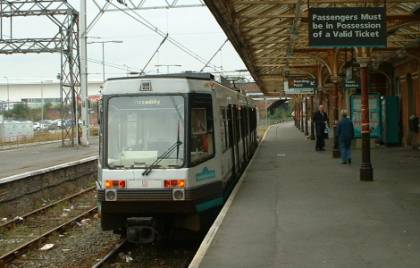
D-1050 Rotary Clubs
Since I do not have much experience attending Rotary Club meetings in Japan, I don't know much about how they are different, but one clear difference is that in England, without fail, members get together about 30 minutes before the meeting starts to drink and chat at either an annex of the meeting place or at a bar in a separate room. Our GSE team always attended such gatherings, and I made it a point to always order a local beer during this time.
British beers can be roughly classified into two types: lager and bitter. Lager
beers are basically the same as the beer we drink in Japan. Bitter, however,
has a deeper, cloudier color, and 100% of the local beers I tried were of this
type. There were a variety of tastes depending on the names of the beers, but
even those beers with the same name tasted different depending upon where they
were made. Guinness, which we know about here in Japan, is supposedly the most
delicious because of the water that is used to make it in Scotland.

When we had to give our GSE presentation, I would order a drink called a "shandy,"
which is a mixture of beer and lemonade. It tastes good and has a low alcohol
content, so I recommend it.
Our presentation consisted of our showing our 2004 International Convention
promotion video, and PowerPoint presentations by each of the team members about
the climate, history, tourist spots, and food of Osaka. After we were done,
Team Leader Nakanishi spoke about the long history of relations between Japan
and England, and compared the Rotary spirit to the Buddhist practice of alms
collection. At all the clubs, everyone listened very intently to our poor English
and laughed at the appropriate times. From the beginning to the end, the atmosphere
was very congenial, and our fears about whether or not our presentation would
go well or not disappeared.
At the district conference, we decided to do some kind of Japanese skit, and
before our departure, we were all at a loss as to what to do. Then Mr. Nakanishi
had the idea of doing something based upon the Japanese custom of throwing beans
to drive away evil spirits, so we prepared a skit based on this theme. We got
the district governor and GSE chairman to take part in the skit with us. They
wore "devil" masks with us and took part without any practice at all.
During the skit we made use of paper spider webs, such as are used in traditional
kabuki theater, and I think we did all right.
Vocational Study
During my vocational study trips, I was able to visit five different places,
which were under the jurisdiction of the Greater Manchester County Fire Service
and Cheshire Fire Service. I visited fire stations, the Stockport Ambulance
Station, Cheshire Police Search Team, and the Bomb Disposal Unit of the Royal
Logistic Corps.
Fire stations in England are on the metropolitan or prefectural (state) level
as far as Japan is concerned, whereas Japanese fire stations are on the city
or village level. Also, they do not involve ambulance service. Ambulance services
are provided by a completely separate entity, the NHS (National Health Service)
Trust and are a public medical treatment organization (in Japan, ambulance services
are provided by fire stations). One part of the NHS is the ambulance service,
and their ambulances are dispatched from "ambulance stations" instead
of fire stations.
Fire Stations in England
Except for the lack of ambulance service, the work of British firemen is basically
the same as here in Japan.
1. Putting out fires
2. Providing first aid at traffic accident sites, etc.
3. Dealing with gas leaks (and other leaks of hazardous materials)
4. Advertising and promotion of fire prevention information
5. Teaching volunteers and local citizens rudimentary fire fighting skills
The environment around the fire stations and conditions in the residential areas are different than Japan, though, so there were some differences in how British firemen go to fires. Unlike Japan, most houses in England are made of brick or stone, so it is hard for fires to spread from one house to another. For this reason, they only send out two fire engines to deal with most fires.
Their fire engines are bigger than those in Japan, and due to poor water service
(as I mentioned earlier), their fire engines carry 1,800 liters of water. Six
firemen ride along on each engine, and because they also carry rescue equipment,
they handle those duties as well.
In Osaka, if there is a fire in some residential area, we send out five fire
engines, two rescue cars, one ladder truck, one ambulance and one command car.
In other words, we send ten vehicles. Depending upon the housing density and
danger of spreading, we send even more vehicles. Those involved in rescue operations
wear bright orange uniforms and have their own special vehicles and equipment.
The average fire engine carries four firemen and carries no water. We pump our
water from fire hydrants.
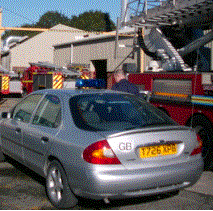
The biggest difference between Japan and England is the command car. The command
car is responsible for coordinating orders and controlling the operations. No
matter how you look at it, in England such cars look like average household
cars. In fact, in England, once you reach a certain rank in leadership, you
have your own personal car equipped with a wireless radio, siren, flashing light
and other necessary equipment. You could say it is the fireman's version of
the unmarked police car. They take this car to work when they go to the fire
station and use it to go to the fire site after they put their flashing light
on the roof and turn on their siren.
Even after finishing their shift and returning home, if there is a large fire,
they will be called to report for duty, even on their day off (which is the
same as in Japan). They will go to the fire directly from their home with their
siren blaring. With this system, they are able to deal quickly with fires no
matter where they are at the time. It also results in savings on maintenance
and repair costs. I was able to catch a glimpse of practical British innovation.
However, with this system, it is possible for you to go to a fire from anywhere,
and it is hard for them to relax and get a good rest. No matter what country
you are in, it is tough being a part of middle management. I was allowed to
ride along in a command car and to get a guided tour of all the fire stations
by the commander. While doing this, he got two calls and we responded to them
from where we were.
The first fire was at a textile manufacturing plant that deals with resins,
and fortunately, the sprinkler system worked well and put the fire out before
we got there. The second fire involved a van. Just one fire engine responded
to that call, but before it could arrive at the scene, it was rear-ended by
another car. Because of this accident, another engine was called in and we were
called to the scene as well.
When we arrived, the fire was already out, and the driver of the car that hit
the first engine was being put into the ambulance. Fortunately, there was little
damage to the fire engine and the woman in the other car was only slightly injured.
Since there are six people on British fire engines, two can work to put out
the fire while the other four are free to handle rescue and first aid operations.

I should mention that I gave a speech at our farewell party and mentioned the
differences between firefighting in Japan and England. I said that if we had
been in a similar situation in Japan (with just four men on the engine) and
had to choose between fighting the fire and helping the accident victim, I would
have chosen the rescue operations because the girl in the car was young and
beautiful. When I shared the punch line, the place filled with laughter. In
fact, the reaction was much greater than I had anticipated, and I felt a bit
embarrassed. Anyway, in Osaka, the rescue vehicles and ambulances go to vehicular
fires together, so there's no need to worry.
Riding along in a British ambulance
I was able to ride along in an ambulance from the Stockport Ambulance Station
on a day when I had no other visits scheduled. The Rotarian who made the arrangements
was affiliated in some way with the NHS, and he made it possible for me to have
this valuable experience.

That day, team leader Nakanishi accompanied me to the ambulance station, but
the very moment I arrived, an ambulance was called out and I was hustled into
the ambulance and left without even having a chance to introduce myself. Mr.
Nakanishi was left behind. Later, soon after returning to the ambulance station,
another call came in and we rushed off again. It was around noon when we finally
returned. When I got there, I noticed that Mr. Nakanishi was nowhere in sight.
He had gone out in another ambulance while I was away!
In Japan, it is absolutely unheard of for someone who is not a medical person
to ride in an ambulance. I was a bit worried that Mr. Nakanishi's ambulance
might be involved in handling a severely injured person or someone in cardio-pulmonary
distress. When I finally saw him sometime after noon, I realized my worries
had been unfounded, and he had an even more valuable experience than I had had.
He seemed very content.
Because ambulances in England are under the jurisdiction of the NHS, they are
much better equipped than those in Japan, as far as medicine and treatment equipment
is concerned. And even more, they are much better received when it comes to
finding a hospital to take the patient. Things are much smoother in England
than Japan, where some hospital refuse to take patients. Still, the conditions
and situations faced by ambulance workers in England and Japan are very similar.
Just as in Osaka, officials in this region are struggling over issues related
to an increasing number of ambulance calls and personnel management. Based on
the analysis of past data on emergencies, they are working on a system that
will increase and decrease the number of ambulances on duty based on the day
of the week and time slot. Along with an increase in ambulance calls, we are
faced with the reality of limitations on the number of new ambulances and new
workers, and the concern that under those limitations, it may not be enough
to meet the need. By the end of last year, the number of calls coming in daily
was over 700, the most ever. Naturally, the total number of calls for 2002 was
also the highest ever, coming to a total of 178,349. If this trend continues
at this pace, it is possible that someone calling 119 for help may hear the
message, "All the ambulances are in use at the moment. Please wait a while
until one returns." I was able to see epoch-making innovations in England,
but even if you have an ambulance, if there is no hospital to take the patient
to, what good is it?
Anti-terrorism measures
Arrangements were made for me to spend some time with the police force and some
military personnel to study some of their methods of dealing with "large-scale
disasters resulting from crimes such as arson, terrorism, etc."
In 1996, a member of the Cheshire Police force came to Japan as a GSE team
member (D-2780 in Kanagawa). Martin Becker works with the Cheshire Police Search
Team, and he arranged for me to visit the Bomb Disposal Unit of the Royal Logistic
Corps.
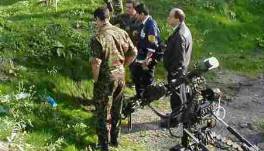
The search team takes charge whenever there is a terror warning at any large
gatherings or when VIPs are visiting the area. They are involved with bomb searches,
investigations and following leads related to missing persons, etc. At the Bomb
Disposal Unit of the Royal Logistic Corps, I was given a lecture on the various
types of booby traps used often by terrorists and saw a demonstration of the
robot they use to deal with the disposal of bombs. The things I learned during
these visits about how to actually search for and deal with bombs and how to
deal with leads was extremely interesting.
Educating school children
I had the chance to sit in on a program sponsored by the Greater Manchester
County Fire Service while I was visiting there. It was a lecture for primary
school children on crisis management. The Royal Army offers the use of its facilities
so that students can hear firemen, rescue workers, policemen and electricians
talk about their specialties at various booths. Primary school students attend
lectures in a group (divided by school year). The day I was there, students
came by bus (they appeared to be 2nd or 3rd graders) and listened to various
lectures in order about how to escape from a burning building, how to perform
simple life-saving procedures (how to help people who are having difficulty
breathing, how to call for help, etc.), how to operate alarms and how to dial
for assistance (999), how to behave around electrical work sites (in England,
the power lines are underground, so during construction and repair work, it
can be dangerous for children) and accident prevention measures. I was deeply
moved by the care and approved educational programs provided to British children.
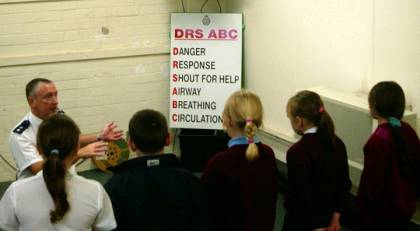
In Conclusion
It was a short stay of just one month, but looking back now on my time in England,
I can say that "I've come to love England." I truly mean it.
The yen has dropped in value recently, and except for beer and Wedgewood china,
just about everything I saw was rather expensive. Wherever I went, I saw security
cameras, and all my host families had burglar alarms installed in their homes.
I would never consider it an ideal place to live, but if I have the chance,
I would like to visit England again.
I'm not really sure why, but for some reason, through my experiences in England,
I've come to love the British people. What about the people we met there? I
wonder if they now have me interest in Japan and if they like Japan. It would
be nice if they did.
Through my vocational study, I came to a fresh realization that "there are no borders when it comes to fire fighting."
"I want to save more lives, relieve more suffering, and reduce damages
and losses even just a little." Even if we cannot communicate well, I know
that there are others all over the world who have the same desire, the same
will as I do. This realization will surely be a great encouragement to me in
the future as a fireman.
Lastly, I want to express my gratitude to team leader Nakanishi and my fellow GSE team members, Ms. Daigo, Ms. Sano, and Mr. Koike. I also want to say thank you to all my host families, the Rotarians in Japan and England, and those I met during my vocational study who are involved in fire fighting, rescue operations, police work and the military. Thank you to all of you!